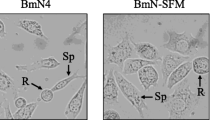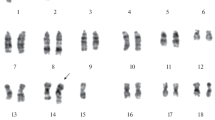Abstract
Two mouse hybridoma cell lines cultured in different basal media with the iron-rich protein-free supplement were subjected to deliberate starvation by inoculation into media diluted with saline to 50% or less. In the diluted media the growth was markedly suppressed and a large fraction of cells died by apoptosis. The cells could be rescued from apoptotic death by individual additions of amino acids, such as glycine, L-alanine, L-serine, L-threonine, L-proline, L-asparagine, L-glutamine, L-histidine, D-serine, β-alanine or taurine. Amino acids with hydrophobic or charged side chains were without effect. The apoptosis preventing activity manifested itself even in extremely diluted media, down to 10% of the standard medium. The activity of L-alanine in the protection of cells starving in 20% medium was shown also in semicontinuous culture. In the presence of 2 mM L-alanine the steady-state viable cell density more than doubled, with respect to control, and the apoptotic index dropped from 37% in the control to 16%. It was concluded that the apoptosis-preventing amino acids acted as signal molecules, rather than nutrients, and that the signal had a character of a survival factor. The specificity of present results, obtained with two different hybridomas, supports our view (Franěk and Chládková-Šrámková, 1995) that the membrane transport macromolecules themselves may play the role of the recognition elements in a signal transduction pathway controlling the survival of hybridoma cells.
Similar content being viewed by others
References
Al-Rubeai M, Mills D and Emery AN (1990) Electron microscopy of hybridoma cells with special regard to monoclonal antibody production. Cytotechnology 4: 13–28.
Bushell ME, Bell SL, Scott MF, Spier RE, Wardell JN and Sanders PG (1994) Enhancement of monoclonal antibody yield by hybridoma fed-batch culture, resulting in extended maintenance of viable cell population. Biotechnol. Bioeng. 44: 1099–1106.
Christensen HN, Liang M and Archer EG (1967) A distinct Na+-requiring transport system for alanine, serine, cysteine, and similar amino acids. J. Biol. Chem. 242: 5237–5246.
Eagle H (1959) Amino acid metabolism in mammalian cell cultures. Science 130: 432–437.
Eagle H and Piez K (1962) The population-dependent requirement by cultured mammalian cells for metabolites which they can syntetize. J. Exp. Med. 116: 29–43.
Franěk F (1995) Starvation-induced programmed death of hybridoma cells: Prevention by amino acid mixtures. Biotechnol. Bioeng. 45: 86–90.
Franěk F and Chládková-Šrámková K (1995) Apoptosis and nutrition: Involvement of amino acid transport system in repression of hybridoma cell death. Cytotechnology 18: 113–117.
Franěk F and Dolníková J (1991) Nucleosomes occurring in protein-free hybridoma cell culture. Evidence for programmed cell death. FEBS Letters 284: 285–287.
Franěk F and Dolníková J (1991a) Hybridoma growth and monoclonal antibody production in iron-rich protein-free medium: Effect of nutrient concentration. Cytotechnology 7: 33–38.
Franěk F, Vomastek T and Dolníková J (1992) Fragmented DNA and apoptotic bodies document the programmed way of cell death in hybridoma cultures. Cytotechnology 9: 117–123.
Hiller GW, Clark DS and Blanch HW (1993) Cell retentionchemostat studies of hybridoma cells — Analysis of hybridoma growth and metabolism in continuous suspension culture on serum-free medium. Biotechnol. Bioeng. 42: 185–195.
Kilberg MS (1986) System A-mediated amino acid tranport: metabolic control at the plasma membrane. Trends Biochem. Sci. 11: 183–186.
Kilberg MS, Handlogten ME and Christensen HN (1980) Characteristics of an amino acid transport system in rat liver for glutamine, asparagine, histidine, and closely related analogs. J. Biol. Chem. 255: 4011–4019.
Kilberg MS, Hutson RG and Laine RO (1994) Amino-acid regulated gene expression in eukaryotic cells. FASEB J. 8: 13–19.
Ley KD and Tobey RA (1970) Regulation of initiation of DNA synthesis in Chinese hamster cells II. Induction of DNA synthesis and cell division by isoleucine and glutamine in G1-arrested cells in suspension culture. J. Cell Biol. 47: 453–459.
Mercille S and Massie B (1994) Induction of apoptosis in nutrient-deprived cultures of hybridoma and myeloma cells. Biotechnol. Bioeng. 44: 1140–1154.
Mosmann T (1983) Rapid colorimetric assay for cellular growth and survival: Application to proliferation and cytotoxicity assay. J. Immunol. Methods 65: 55–63.
Oxender DL, Lee M and Cecchini G (1977) Regulation of amino acid transport activity and growth rate of animal cells in culture. J. Biol. Chem. 252: 2680–2683.
Raff M (1992) Social controls on cell survival and cell death. Nature 356: 397–400.
Raff MC, Barres BA, Burne JF, Coles HS, Ishizaki Y and Jacobson MD (1993) Programmed cell death and the control of cell survival: Lessons form the nervous system. Science 262: 695–699.
Shafqat S, Tamarappoo BK, Kilberg MS, Puranam RS, McNamara JO, Guadano-Ferraz A and Fremeau RT Jr. (1993) Cloning and expression of a novel Na+-dependent neutral amino acid transporter structurally related to mammalian Na+/glutamate cotransporters. J. Biol Chem. 268: 15351–15355.
Shotwell MA, Kilberg MS and Oxender DL (1983) The regulation of neutral amino acid transport in mammalian cells. Biochim. Biophys Acta 737: 267–284.
Shotwell MA, Mattes PM, Jayme DW and Oxender DL (1982) Regulation of amino acid transport system L in Chinese hamster ovary cells. J. Biol Chem. 257: 2974–2980.
Singh RP, Al-Rubeai M, Gregory CD and Emery AN (1994) Cell death in bioreactors: A role for apoptosis. Biotechnol. Bioeng. 44: 720–726.
Tupper JT, Mills B and Zorgniotti F (1976) Membrane transport in synchronized Ehrlich sscites tumor cells: Uptake of amino acids by the A and L system during the cell cycle. J. Cell Physiol 88: 77–88.
Vomastek T and Franěk F (1993) Kinetics of development of spontaneous apoptosis in B cell hybridoma cultures. Immunol. Letters 35: 19–24.
Williams GT and Smith CA (1993) Molecular regulation of apoptosis: Genetic controls on cell death. Cell 74: 777–779.
Author information
Authors and Affiliations
Rights and permissions
About this article
Cite this article
Franěk, F., Šrámková, K. Cell suicide in starving hybridoma culture: survival-signal effect of some amino acids. Cytotechnology 21, 81–89 (1996). https://doi.org/10.1007/BF00364839
Received:
Accepted:
Issue Date:
DOI: https://doi.org/10.1007/BF00364839




